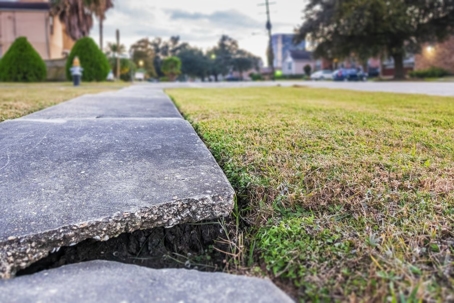Since the work-from-home era started, taking outdoor walks has been a common activity for many households. But what happens when hazards start to take over a pedestrian walkway? The safety of you and your loved ones is suddenly jeopardized. Suing the city for an unsafe sidewalk could be an option, but sometimes there could be more legal effective solutions when you’re affected by a hazardous walking path. Let’s explore your options if you encounter an unsafe walkway that results in injury.
Lawsuit vs. City
Local governments oversee all public pathways. They usually have departments that are responsible for not only building sidewalks, but also maintaining them. So, if a sidewalk has numerous cracks that cause you to trip and fall, it is possible you could open a lawsuit against the city for its lack of upkeep. There are a few remaining factors to check off first though. Here are three questions to ask yourself before moving forward with a lawsuit against the city or local government.
- Was the incident truly a result of the sidewalk’s condition?
- Did the incident take place on public property?
- Were weather conditions safe at the time of the incident?
Did you answer yes to all of these questions? If so, then you might have a case for suing the city due to an unsafe sidewalk. Your next step should be to contact an attorney as soon as possible. Some local governments have regulations in place that protect them from a citizen opening a lawsuit against them for something that happened months or even years ago. In most cities and states, it is recommended that a pedestrian initiate a lawsuit against a city within 30 days of the incident taking place.
Lawsuit vs. Business
Being that a lot of businesses are located near parks, a public pathway could be on private property. In this case, a business or company would be responsible for the maintenance and repairs of an unsafe sidewalk. While your first instinct might be to confront the store owner about the state of the pathway, it’s always best to seek legal guidance first. A team of attorneys will be able to consult you on the next steps you should take in order to find a solution that’s in your best interest.
It’s also possible that a business isn’t liable even if the walkway is in front of their store. Sometimes, the city relies on store fronts to monitor cracks and potholes on roads and sidewalks around their property. In a lot of cases, a store owner will report an issue but the government will take a while to get back to them. This is another reason why it’s always a good idea to get a legal team involved. It’s possible the target of your lawsuit could change in due time.
Lawsuit vs. Resident
Much like a business having a pathway in front of its doors, a lot of city residents have sidewalks in front of their houses. If you trip over an unsafe slab of sidewalk in front of someone’s home, it’s best to do some research on who is responsible for the upkeep of the path you were impacted by. This is where a lot of cities have grey areas in liability. Some cities rely on residents to report unsafe sidewalk conditions, while other cities have local officials who write requests for repairs to be made. In some rare cases, a city will hold its residents responsible for the maintenance of a walkway so long as it’s on their property. This is where a lawsuit could be opened against a resident.
Again, before confronting a resident about their unsafe sidewalk and the injuries it may have caused you, it’s important to seek legal assistance. At Hester Law Group, our team of legal professionals can provide the needed guidance for any pedestrian seeking compensation.
For more information regarding personal injury lawsuits against a city, business, or residence, contact Hester Law Group today!

